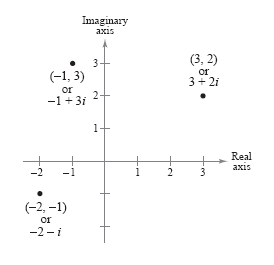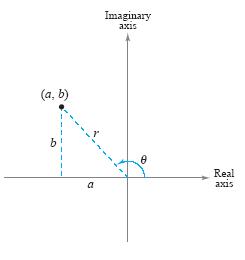Polar Form of a Complex Number
Just as real numbers can be represented by points on the real number line, you can
represent a complex number z = a + bi
at the point (a, b) in a coordinate plane (the complex plane). The horizontal axis is
called the real axis and the vertical axis is called the imaginary axis, as shown in
the figure below.

The absolute value of the complex number a + bi is defined as the distance
between the origin (0, 0) and the point (a, b).
The Absolute Value of a Complex Number
The absolute value of the complex number z = a + bi is given by

NOTE
If the complex number a + bi
is a real number (that is, if b = 0), then
this definition agrees with that given for
the absolute value of a real number.

To work effectively with powers and roots of complex numbers, it is helpful to
write complex numbers in polar form. In the figure below, consider the nonzero complex
number a + bi.

By letting θ be the angle from the positive x-axis (measured counterclockwise)
to the line segment connecting the origin and the point (a, b), you can
write a = cos θ and b = r sin
θ where
 Consequently, you have Consequently, you have
a + bi = (r cos θ) + (r sin
θ)i
from which you can obtain the polar form of a complex number.
Polar Form of a Complex Number
The polar form of the complex number z = a + bi is
z = r (cos θ + i sin θ)
where a = r cos θ, b = r sin θ,
 and
tan θ = b/a. The number r
is the modulus of z, and θ is called an
argument of z. and
tan θ = b/a. The number r
is the modulus of z, and θ is called an
argument of z.
NOTE
The polar form of a complex number is also called the trigonometric form.
Because there are infinitely many choices for θ,
the polar form of a complex number is not
unique. Normally, θ is restricted to the interval
0 ≤ θ < 2π, although on occasion it is convenient
to use θ < 0.
|